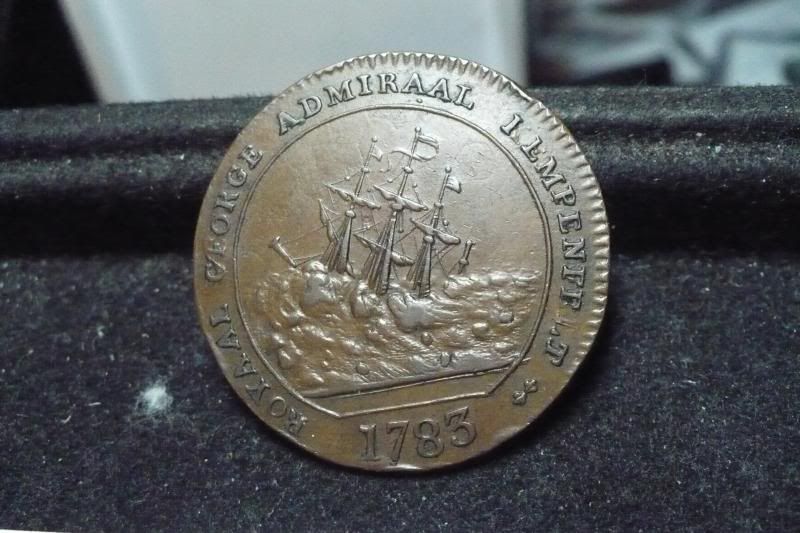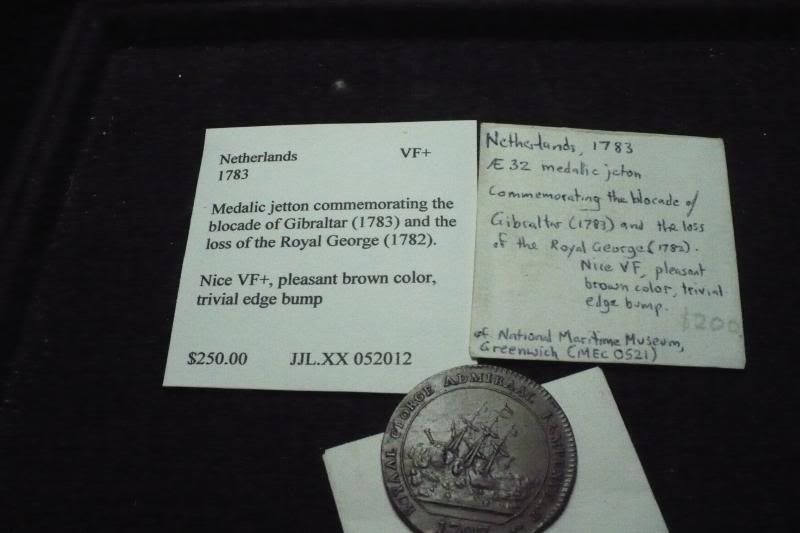ww
x


Dutch medallion commemorating the blockade of Gibraltar and the loss of HMS Royal George
Obverse: View on the Rock of Gibraltar and ships engaged, T GEBLOQUEERDE GIBRALTAR (the blockaded Gibraltar), 1783 in exergue
Reverse: HMS Royal George sinking, ROYAAL GEORGE ADMIRAAL KEMPENVELT (Royal George, admiral Kempenfelt), 1783 in exergue
Diameter: 33mm
HMS Royal George was a 100-gun first-rate ship of the line of the Royal Navy, built at Woolwich Dockyard and launched on 18 February 1756. The largest warship in the world at the time of launching, she saw service during the Seven Years' War including being Admiral Sir Edward Hawke's flagship at the Battle of Quiberon Bay and later taking part in the Battle of Cape St Vincent. She also partook in missions to relieve The Great Siege of Gibraltar, which was an unsuccessful attempt by Spain and France to capture Gibraltar from the British during the American War of Independence. The Great Siege was the largest action fought during the war in terms of numbers, particularly the Grand Assault on 18 September 1782. At three years and seven months, it is also the longest siege endured by the British Armed Forces.
On 28 August 1782 Royal George was preparing to sail with Admiral Howe's fleet to relieve Gibraltar. The ships were anchored at Spithead to take on supplies. Most of her complement were aboard ship, as were a large number of workmen to speed the repairs. At seven o’clock on the morning of 29 August work on the hull was carried out and Royal George was heeled over by rolling the ship's guns on one side into the centreline of the ship. This caused the ship to tilt over in the water. The ship was heeled over too far, passing her centre of gravity, and she rolled over and sank, taking with her more than 800 lives. It is still one of the most serious maritime losses to have occured in British waters.



Dutch medallion commemorating the blockade of Gibraltar and the loss of HMS Royal George
Obverse: View on the Rock of Gibraltar and ships engaged, T GEBLOQUEERDE GIBRALTAR (the blockaded Gibraltar), 1783 in exergue
Reverse: HMS Royal George sinking, ROYAAL GEORGE ADMIRAAL KEMPENVELT (Royal George, admiral Kempenfelt), 1783 in exergue
Diameter: 33mm
HMS Royal George was a 100-gun first-rate ship of the line of the Royal Navy, built at Woolwich Dockyard and launched on 18 February 1756. The largest warship in the world at the time of launching, she saw service during the Seven Years' War including being Admiral Sir Edward Hawke's flagship at the Battle of Quiberon Bay and later taking part in the Battle of Cape St Vincent. She also partook in missions to relieve The Great Siege of Gibraltar, which was an unsuccessful attempt by Spain and France to capture Gibraltar from the British during the American War of Independence. The Great Siege was the largest action fought during the war in terms of numbers, particularly the Grand Assault on 18 September 1782. At three years and seven months, it is also the longest siege endured by the British Armed Forces.
On 28 August 1782 Royal George was preparing to sail with Admiral Howe's fleet to relieve Gibraltar. The ships were anchored at Spithead to take on supplies. Most of her complement were aboard ship, as were a large number of workmen to speed the repairs. At seven o’clock on the morning of 29 August work on the hull was carried out and Royal George was heeled over by rolling the ship's guns on one side into the centreline of the ship. This caused the ship to tilt over in the water. The ship was heeled over too far, passing her centre of gravity, and she rolled over and sank, taking with her more than 800 lives. It is still one of the most serious maritime losses to have occured in British waters.
If you can't swim you better stay in the boat.......
0